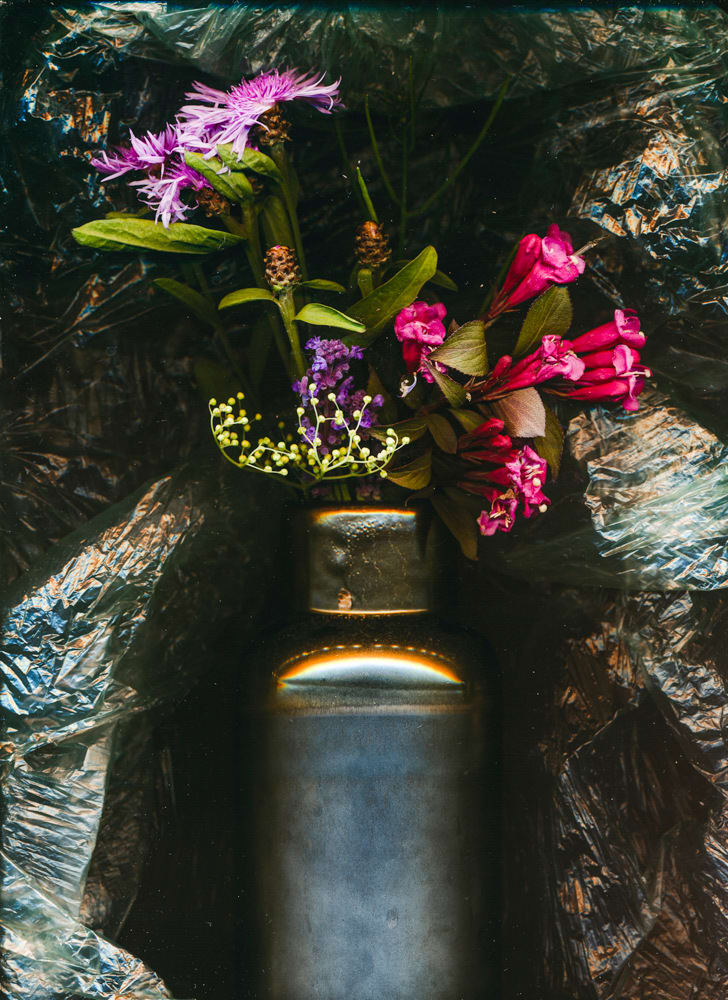Tilyen Mucik
II. Tihožitje / II. Still Life, 2019
skenogram Inkjet print Hahnemuhle photosilk baryta 310g / scanogram Inkjet print Hahnemuhle photosilk baryta 310g
35 x 35 cm
edicija 2/3 + 1 AP / edition 2/3 + 1 AP
Series: TIHOŽITJE / STILL LIFE
podpisana in datirana / signed and dated
For English version please scroll down. O SERIJI Motiv tihožitja je v polju vizualne umetnosti zgodovinsko eden najpogosteje reprezentiranih in začetke tihožitnih podob lahko zasledimo že v stenskem slikarstvu starih...
For English version please scroll down.
O SERIJI
Motiv tihožitja je v polju vizualne umetnosti zgodovinsko eden najpogosteje reprezentiranih in začetke tihožitnih podob lahko zasledimo že v stenskem slikarstvu starih civilizacij. A motiv, ki je bil vse od renesanse naprej priljubljena upodobitev številnih umetnikov, se v 19. stoletju začne izrazito povezovati z ženskimi umetnicami. Ženskam namreč ni bilo dovoljeno obiskovanje likovnih akademij, preučevanje golega telesa ter slikanje večfiguralnih kompozicij in v svojem delu so bile zamejene na slikanje intimnega sveta interierjev, portretov in tihožitij. Tematika ženske in ženstvenosti je v njenem delu vseskozi prisotna, ne le v samem izboru motiva temveč v njeni lastni interpretaciji serije. Tihožitje lahko beremo npr. skozi pisanje Linde Nochlin, ki med drugim postavlja vprašanje, kaj naredi določeno umetniško delo »žensko« oz. »ženstveno«, ali sploh lahko govorimo o ženskem slogu in motivu, kot je bila vse prepogosto praksa v umetnostni zgodovini. Mucik se v svoji seriji Tihožitje glasno sklicuje na preteklo tradicijo, na kar opozarja že sam način upodobitve – fotografije so predstavljene v monumentalnih zlatih okvirjih, ki aludirajo na kolekcionarske zbirke preteklih stoletij. Tehnično pa je serija vse prej kot tradicionalna, saj se z uporabo metode skeniranja odmika od klasičnih fotografskih pristopov. Kljub pomembnim zgodovinskim referencam pa fotografije Tilyen Mucik vsekakor niso zamejene na zgolj feministično branje in delujejo tudi brez referenčnega ozadja. Njeno glavno vodilo je lastna ljubezen do cvetja in pritajenega sveta tihožitnih predmetov, ki za umetnico ostajajo predmet fascinacije.
Hana Čeferin
ABOUT THE SERIES
The motif of still-life is one of the most consistently depicted in the field of visual arts, and its origins can be traced to the wall painting of ancient civilizations. The motif, which has been a popular choice for many artists since the renaissance, became increasingly connected to female artists in the 19th century. Women were forbidden from attaining an education at art academies, were not allowed to study the nude or produce historical paintings with multiple figures. Instead, they were limited to painting intimate interiors, portraits and still lifes. The theme of women and femininity is a constant in Mucik’s work, not only in her choice of a motif but in her own interpretation of the series. Still life can be understood through the writings of Linda Nochlin, who questions the very nature of characterizing a work as “female” or “feminine”, and begs the question of whether we can really speak of a female style or motif, as was the practice throughout art history. Mucik is undeniably evoking the tradition of the past, which is emphasized in the very presentation of her works – the photographs are placed in heavy gold frames, alluding to artistic collections of past centuries. But from a technical perspective, the series is far from traditional, as the artist uses scanning and distances herself from classic photography. Despite important historical references, the works of Tilyen Mucik are not limited to feminist interpretation and function without a referential background. Her leading principle is her personal love of flowers and the subtle world of still life objects, which remain a fascination for the artist.
Hana Čeferin
O SERIJI
Motiv tihožitja je v polju vizualne umetnosti zgodovinsko eden najpogosteje reprezentiranih in začetke tihožitnih podob lahko zasledimo že v stenskem slikarstvu starih civilizacij. A motiv, ki je bil vse od renesanse naprej priljubljena upodobitev številnih umetnikov, se v 19. stoletju začne izrazito povezovati z ženskimi umetnicami. Ženskam namreč ni bilo dovoljeno obiskovanje likovnih akademij, preučevanje golega telesa ter slikanje večfiguralnih kompozicij in v svojem delu so bile zamejene na slikanje intimnega sveta interierjev, portretov in tihožitij. Tematika ženske in ženstvenosti je v njenem delu vseskozi prisotna, ne le v samem izboru motiva temveč v njeni lastni interpretaciji serije. Tihožitje lahko beremo npr. skozi pisanje Linde Nochlin, ki med drugim postavlja vprašanje, kaj naredi določeno umetniško delo »žensko« oz. »ženstveno«, ali sploh lahko govorimo o ženskem slogu in motivu, kot je bila vse prepogosto praksa v umetnostni zgodovini. Mucik se v svoji seriji Tihožitje glasno sklicuje na preteklo tradicijo, na kar opozarja že sam način upodobitve – fotografije so predstavljene v monumentalnih zlatih okvirjih, ki aludirajo na kolekcionarske zbirke preteklih stoletij. Tehnično pa je serija vse prej kot tradicionalna, saj se z uporabo metode skeniranja odmika od klasičnih fotografskih pristopov. Kljub pomembnim zgodovinskim referencam pa fotografije Tilyen Mucik vsekakor niso zamejene na zgolj feministično branje in delujejo tudi brez referenčnega ozadja. Njeno glavno vodilo je lastna ljubezen do cvetja in pritajenega sveta tihožitnih predmetov, ki za umetnico ostajajo predmet fascinacije.
Hana Čeferin
ABOUT THE SERIES
The motif of still-life is one of the most consistently depicted in the field of visual arts, and its origins can be traced to the wall painting of ancient civilizations. The motif, which has been a popular choice for many artists since the renaissance, became increasingly connected to female artists in the 19th century. Women were forbidden from attaining an education at art academies, were not allowed to study the nude or produce historical paintings with multiple figures. Instead, they were limited to painting intimate interiors, portraits and still lifes. The theme of women and femininity is a constant in Mucik’s work, not only in her choice of a motif but in her own interpretation of the series. Still life can be understood through the writings of Linda Nochlin, who questions the very nature of characterizing a work as “female” or “feminine”, and begs the question of whether we can really speak of a female style or motif, as was the practice throughout art history. Mucik is undeniably evoking the tradition of the past, which is emphasized in the very presentation of her works – the photographs are placed in heavy gold frames, alluding to artistic collections of past centuries. But from a technical perspective, the series is far from traditional, as the artist uses scanning and distances herself from classic photography. Despite important historical references, the works of Tilyen Mucik are not limited to feminist interpretation and function without a referential background. Her leading principle is her personal love of flowers and the subtle world of still life objects, which remain a fascination for the artist.
Hana Čeferin


